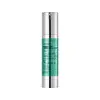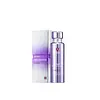What's inside
What's inside
 Key Ingredients
Key Ingredients

 Benefits
Benefits

 Concerns
Concerns

 Ingredients Side-by-side
Ingredients Side-by-side

Water
Skin ConditioningDicaprylyl Carbonate
EmollientCaprylic/Capric Triglyceride
MaskingPolyglyceryl-4 Diisostearate/Polyhydroxystearate/Sebacate
EmulsifyingSorbitol
HumectantPolyglyceryl-4 Isostearate
EmulsifyingNiacinamide
SmoothingButylene Glycol Dicaprylate/Dicaprate
EmollientMagnesium Sulfate
Hyaluronic Acid
HumectantDipropylene Glycol
HumectantPolyurethane-15
1,2-Hexanediol
Skin ConditioningHydroxyacetophenone
AntioxidantDiisostearyl Malate
EmollientSorbitan Olivate
EmulsifyingSynthetic Beeswax
Emulsion StabilisingSilica
AbrasiveEthylhexylglycerin
Skin ConditioningHippophae Rhamnoides Fruit Oil
Skin ProtectingButylene Glycol
HumectantAdenosine
Skin ConditioningButyrospermum Parkii Butter
Skin ConditioningDisodium EDTA
Centella Asiatica Extract
CleansingGlutathione
Glycerin
HumectantSqualane
EmollientTocopherol
AntioxidantPolyglyceryl-10 Laurate
Skin ConditioningCentella Asiatica Callus Extracellular Vesicles
Sodium Hyaluronate
HumectantPanax Ginseng Root Extract
EmollientTripeptide-1
Skin ConditioningSucrose
HumectantHexapeptide-9
Skin ConditioningCopper Tripeptide-1
Skin ConditioningAcetyl Hexapeptide-8
HumectantHydroxypropyltrimonium Hyaluronate
Palmitoyl Pentapeptide-4
Skin ConditioningSodium Dna
Skin ConditioningSodium Acetylated Hyaluronate
HumectantMineral Salts
Skin ConditioningHydrolyzed Hyaluronic Acid
HumectantHydrolyzed Sodium Hyaluronate
Skin ConditioningSodium Hyaluronate Crosspolymer
HumectantMadecassoside
AntioxidantMadecassic Acid
Skin ConditioningPropolis Extract
Skin ConditioningAsiaticoside
AntioxidantAsiatic Acid
Skin ConditioningPotassium Hyaluronate
Skin ConditioningWater, Dicaprylyl Carbonate, Caprylic/Capric Triglyceride, Polyglyceryl-4 Diisostearate/Polyhydroxystearate/Sebacate, Sorbitol, Polyglyceryl-4 Isostearate, Niacinamide, Butylene Glycol Dicaprylate/Dicaprate, Magnesium Sulfate, Hyaluronic Acid, Dipropylene Glycol, Polyurethane-15, 1,2-Hexanediol, Hydroxyacetophenone, Diisostearyl Malate, Sorbitan Olivate, Synthetic Beeswax, Silica, Ethylhexylglycerin, Hippophae Rhamnoides Fruit Oil, Butylene Glycol, Adenosine, Butyrospermum Parkii Butter, Disodium EDTA, Centella Asiatica Extract, Glutathione, Glycerin, Squalane, Tocopherol, Polyglyceryl-10 Laurate, Centella Asiatica Callus Extracellular Vesicles, Sodium Hyaluronate, Panax Ginseng Root Extract, Tripeptide-1, Sucrose, Hexapeptide-9, Copper Tripeptide-1, Acetyl Hexapeptide-8, Hydroxypropyltrimonium Hyaluronate, Palmitoyl Pentapeptide-4, Sodium Dna, Sodium Acetylated Hyaluronate, Mineral Salts, Hydrolyzed Hyaluronic Acid, Hydrolyzed Sodium Hyaluronate, Sodium Hyaluronate Crosspolymer, Madecassoside, Madecassic Acid, Propolis Extract, Asiaticoside, Asiatic Acid, Potassium Hyaluronate
Malus Domestica Fruit Cell Culture Extract
Skin ConditioningMoonstone Extract
Skin ConditioningEel Extract
HumectantCollagen Amino Acids
MoisturisingBletia Hyacinthina Bulb Extract
Skin ConditioningCollagen Extract
Skin ConditioningAcrylates/C10-30 Alkyl Acrylate Crosspolymer
Emulsion StabilisingPolyglyceryl-10 Laurate
Skin ConditioningGlyceryl Polyacrylate
Ethylhexylglycerin
Skin ConditioningAdenosine
Skin ConditioningC12-13 Alketh-3
EmulsifyingDextrin
AbsorbentSodium Sulfate
Beta-Glucan
Skin ConditioningPalmitoyl Tripeptide-5
Skin ConditioningTocopherol
AntioxidantEthylenediamine
Parfum
MaskingLimonene
PerfumingMalus Domestica Fruit Cell Culture Extract, Moonstone Extract, Eel Extract, Collagen Amino Acids, Bletia Hyacinthina Bulb Extract, Collagen Extract, Acrylates/C10-30 Alkyl Acrylate Crosspolymer, Polyglyceryl-10 Laurate, Glyceryl Polyacrylate, Ethylhexylglycerin, Adenosine, C12-13 Alketh-3, Dextrin, Sodium Sulfate, Beta-Glucan, Palmitoyl Tripeptide-5, Tocopherol, Ethylenediamine, Parfum, Limonene
Alternatives
Ingredients Explained
These ingredients are found in both products.
Ingredients higher up in an ingredient list are typically present in a larger amount.
Adenosine is in every living organism. It is one of four components in nucleic acids that helps store our DNA.
Adenosine has many benefits when used. These benefits include hydrating the skin, smoothing skin, and reducing wrinkles. Once applied, adenosine increases collagen production. It also helps with improving firmness and tissue repair.
Studies have found adenosine may also help with wound healing.
In skincare products, Adenosine is usually derived from yeast.
Learn more about AdenosineEthylhexylglycerin (we can't pronounce this either) is commonly used as a preservative and skin softener. It is derived from glyceryl.
You might see Ethylhexylglycerin often paired with other preservatives such as phenoxyethanol. Ethylhexylglycerin has been found to increase the effectiveness of these other preservatives.
Polyglyceryl-10 Laurate is an ester of lauric acid and Polyglycerin-10.
Polyglyceryl-10 Laurate is a cleansing agent and emulsifier. It helps gather dirt, oil, and other pollutants to be rinsed away. As an emulsifier, it helps prevent ingredients from separating, such as oil and water.
Polyglyceryl-10 Laurate may not be fungal acne safe.
Learn more about Polyglyceryl-10 LaurateTocopherol (also known as Vitamin E) is a common antioxidant used to help protect the skin from free-radicals and strengthen the skin barrier. It's also fat soluble - this means our skin is great at absorbing it.
Vitamin E also helps keep your natural skin lipids healthy. Your lipid skin barrier naturally consists of lipids, ceramides, and fatty acids. Vitamin E offers extra protection for your skin’s lipid barrier, keeping your skin healthy and nourished.
Another benefit is a bit of UV protection. Vitamin E helps reduce the damage caused by UVB rays. (It should not replace your sunscreen). Combining it with Vitamin C can decrease sunburned cells and hyperpigmentation after UV exposure.
You might have noticed Vitamin E + C often paired together. This is because it is great at stabilizing Vitamin C. Using the two together helps increase the effectiveness of both ingredients.
There are often claims that Vitamin E can reduce/prevent scarring, but these claims haven't been confirmed by scientific research.
Learn more about Tocopherol